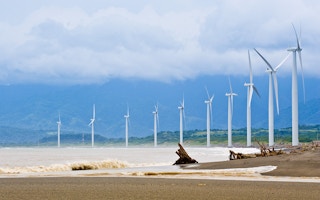The latest draft of the Philippine Energy Plan (PEP), which will chart the country’s energy landscape up until 2040, is unfortunately not what Filipinos need in order to build back better.
To continue reading, subscribe to Eco‑Business.
There's something for everyone. We offer a range of subscription plans.
- Access our stories and receive our Insights Weekly newsletter with the free EB Member plan.
- Unlock unlimited access to our content and archive with EB Circle.
- Publish your content with EB Premium.
We need a massive redraft by the government that will bring about an energy transition, lower electricity costs and more widespread benefits for businesses and households. We need to integrate elements of a “green recovery” from the Covid-19 pandemic into the plan.
The draft PEP proposes a significant share of coal and oil in the energy mix—58.9 per cent by 2030, and 55.6 per cent by 2040.
Under its projected business-as-usual scenario, a total of 18.9 gigawatts (GW) of coal capacity will be installed by 2030 and this will rise to 31.5 GW by 2040. Power generation from coal is projected to rise to 218 terawatt hours annually—almost four times greater than our current coal use and twice the current electricity consumption of the country. Renewable energy is set to make up 26.3 per cent of the energy mix in 2040 under this scenario.
The draft PEP’s clean energy scenario, meanwhile, anticipates the adoption of “highly efficient” coal and natural gas technologies and 1.2 GW of nuclear power. Renewable energy would only account for 31.9 per cent of the power mix by 2030, lower than the goal of 35 per cent previously touted by the Philippine Department of Energy.
It is worth noting that the share of renewable energy in the country’s generation mix has already dropped in recent years despite a national law for renewable energy promotion and development in place since 2008. From more than 23 per cent in 2018, the share of renewable energy fell to 21 per cent in 2019.
While the opportunity to comment on the draft PEP is welcomed, many energy stakeholders are deeply concerned and, frankly, alarmed by the lack of plans for a serious energy transition and green recovery from Covid-19. The Philippines is at a crucial juncture in deciding its energy future as the population grows, manufacturing expands and electricity demand rises. Balancing sustainability, affordability and security is a critical and ongoing challenge that must be addressed by the PEP.
In response to demand from stakeholders, a platform I lead in the Philippines hosted four virtual dialogues from May to July this year that gathered more than 700 energy stakeholders from government, financial institutions, private distribution utilities, cooperatives, renewable energy developers, as well as a major car manufacturing group and the small and medium enterprises in its supply chain.
Through these virtual dialogues and our broader market engagement over the past three years in the Philippines, we have three primary observations of the draft PEP.
1. It falls short of the Philippines’ goal to have 35 per cent of energy derived from renewable sources by 2030
The draft PEP’s goal of 20 GW renewable energy capacity by 2040 will not be enough to meet the energy department’s target of 35 per cent by 2030.
At a webinar on 15 June, leaders from the Energy Regulatory Commission, National Renewable Energy Board and Department of Energy reiterated their goal of providing clean, affordable, and reliable electricity to all Filipinos. They highlighted renewable energy as the answer to this. Recognising that the share of renewable energy in the energy mix has fallen in recent years, the government agencies committed to redoubling efforts through consumer-centric and demand-driven policies and programmes.
To meet the 2030 target, we need an additional 40 terawatt hours, or approximately 20 GW of additional renewable energy capacity by 2030, a decade ahead of the timeline expressed in the draft PEP.
2. No overarching plans for renewable energy
While the energy department has existing and emerging policies such as net metering, the green energy option programme and competitive renewable energy zones to promote renewable energy, they are not explicitly mentioned in the PEP. For example, there is no in-depth discussion on the upcoming green energy auction policy and how developers could take advantage of the identified “renewable energy zones”—regions characterised by high-quality resource potential, cost-competitiveness and high levels of private sector interest—when submitting bids.
3. No mention of battery energy storage systems or details of a smart grid roadmap
The draft PEP does not outline any plans to take advantage of battery energy storage systems to enhance grid stability, security and reliability. Energy storage by way of utility-scale batteries should be part of the new plan, considering the rapidly declining costs of batteries and their outsized importance in bringing about a cost-competitive and constant electricity supply from renewable sources.
We hope that government leaders take these observations into account as they strengthen and revise the draft PEP. Based on the experience of Vietnam and other emerging markets, clear and well-defined policy signals attract much-needed investments at speed and scale—Vietnam increased its solar capacity by a staggering 5 GW in one year. Therefore, more aggressive and comprehensive renewable energy goals should be considered in the PEP.
Battered by the pandemic, the Philippines’ unemployment rate hit a record high of 17.7 per cent in June and its economy is now expected to shrink by 7.3 per cent in 2020. Building back better will require quick and coordinated action across many stakeholders, and leaders will need to simultaneously address urgent socioeconomic concerns.
I want to highlight the ability of the clean energy sector to rapidly create jobs. Being decentralised and modular in character, clean energy systems create employment opportunities throughout the supply chain and draw from a diverse and inclusive employment pool that ranges from unskilled labour to high-level executives. The sector also creates local employment opportunities, mostly within small and medium enterprises that make up an overwhelming 99.6 per cent of all registered businesses in the Philippines and employ over 70 per cent of the workforce.
Doubling down on coal is not the way to pull any country out of crisis mode. Shifting towards a modern, low-carbon energy path will help secure our future as an economic powerhouse and create jobs, address climate change and improve public health. We need the PEP to chart the right way forward.
Marlon Apanada is the Philippines lead of a clean energy promotion and investment mobilisation platform funded by donors and philanthropic partners. A certified green finance specialist, he successfully developed the first bank-financed solar projects in the Philippines and advised Fortune Global 500 companies on their clean energy procurement goals. He is also the Southeast Asia engagement lead for the World Resources Institute, a global think tank headquartered in Washington, D.C.











